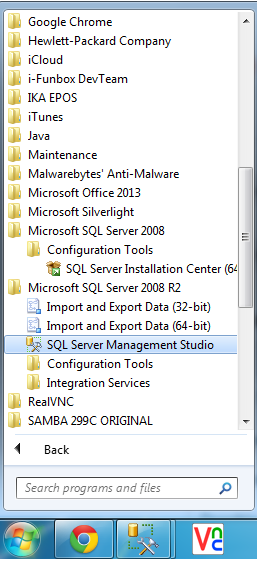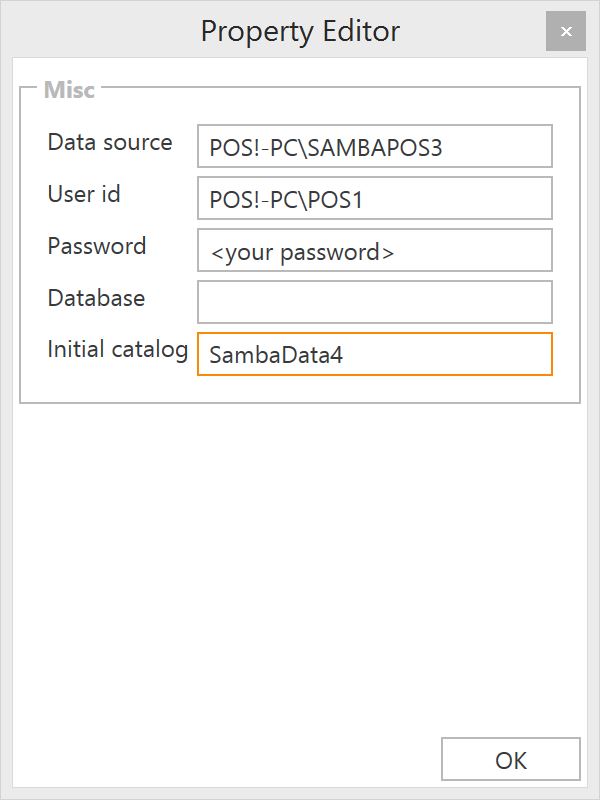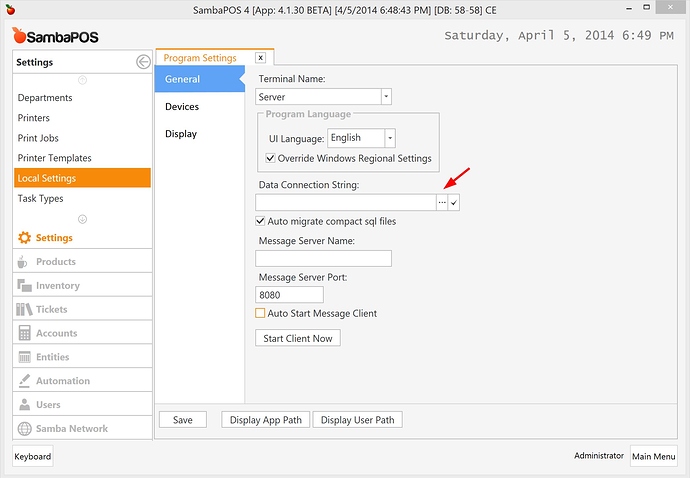Sambapos4 installed. Doesnot want to open. data source=Server-PC\SAMBAPOS4;User Id=sa; Password=sambapos —what is wrong and how do I fix it?
Elizabeth
Is Server-PC your computer name?
and your SQL Server Instance SAMBAPOS4?
Try this string:
Data Source=LOCALHOST\SAMBAPOS4; User Id=sa; Password=sambapos;No my pc name is Pos1-PC. what is my SQL Server Instance and where do \I find it?
Have you installed SQL Server 2012?
Yes I have, thank you for helping me Isaac
It gives an error
- invalid column name ‘screenmenId’
During installation you would have set a INSTANCE name. If you are not sure open SQL Server Management Studio and connect to your database engine:

I have circle, in my case the Server Name - LENOVO and the SQL SERVER INSTANCE NAME which is SQLEXPRESS
If you open up SQL Server Management Studio, we can find out for sure the correct SERVER NAME and INSTANCE NAME.
Where do I find the management link? I am not ver clued up about this.
In your windows programs menu:

@Bonamanzi welcome to SambaPOS forums.
Are you trying to upgrade from a previous version, or you need a fresh start?
I need a fresh start, because the program was not set up correctly. There was a Samba3 on it, but I decided to start with Samba4.
I have found the program.
Great, so start Management Studio, login and expand databases node like @Isaac’s screenshot.
Can you tell us your instance name and what databases listed there?
Server name = POS1-PC\SAMBAPOS3
Servername POS!-PC\SAMBAPOS3
Username POS!-PC\POS1
Open Local Settings and click […] button next to connection string.
Fill details. However user name seems not correct to me. Please double check user name. It is same as you used to login Management Studio.

Normally we leave Initial Catalog empty but I’ve entered a name here to generate a new database.
@emre, I stil cannot get into Sambapos to do those settings, the purple screen comes up and then the error:General Info]
Application: SambaPOS
Version: 4.1.30 BETA
Region: en
DB: SQ
Machine: POS1-PC
User: POS 1
Date: 2014/04/07
Time: 07:36 AM
User Explanation:
POS 1 said “”
Exception Info 1]
Top-level Exception
Type: System.ComponentModel.Composition.CompositionException
Message: The composition produced a single composition error. The root cause is provided below. Review the CompositionException.Errors property for more detailed information.
- Invalid column name ‘ScreenMenuId’.
Resulting in: An error occurred while executing the command definition. See the inner exception for details
Resulting in: An exception occurred while trying to create an instance of type ‘Samba.Modules.DepartmentModule.DepartmentModule’.
Resulting in: Cannot activate part ‘Samba.Modules.DepartmentModule.DepartmentModule’.
Element: Samba.Modules.DepartmentModule.DepartmentModule --> Samba.Modules.DepartmentModule.DepartmentModule --> DirectoryCatalog (Path=“C:\Program Files (x86)\SambaPOS4”)
Resulting in: Cannot get export ‘Samba.Modules.DepartmentModule.DepartmentModule (ContractName=“Microsoft.Practices.Prism.Modularity.IModule”)’ from part ‘Samba.Modules.DepartmentModule.DepartmentModule’.
Element: Samba.Modules.DepartmentModule.DepartmentModule (ContractName=“Microsoft.Practices.Prism.Modularity.IModule”) --> Samba.Modules.DepartmentModule.DepartmentModule --> DirectoryCatalog (Path=“C:\Program Files (x86)\SambaPOS4”)
Resulting in: An exception occurred while initializing module ‘DepartmentModule’.- The exception message was: The composition produced a single composition error. The root cause is provided below. Review the CompositionException.Errors property for more detailed information.
- Invalid column name ‘ScreenMenuId’.
Resulting in: An error occurred while executing the command definition. See the inner exception for details.
Resulting in: An exception occurred while trying to create an instance of type ‘Samba.Modules.DepartmentModule.DepartmentModule’.
Resulting in: Cannot activate part ‘Samba.Modules.DepartmentModule.DepartmentModule’.
Element: Samba.Modules.DepartmentModule.DepartmentModule --> Samba.Modules.DepartmentModule.DepartmentModule --> DirectoryCatalog (Path=“C:\Program Files (x86)\SambaPOS4”)
Resulting in: Cannot get export ‘Samba.Modules.DepartmentModule.DepartmentModule (ContractName=“Microsoft.Practices.Prism.Modularity.IModule”)’ from part ‘Samba.Modules.DepartmentModule.DepartmentModule’.
Element: Samba.Modules.DepartmentModule.DepartmentModule (ContractName=“Microsoft.Practices.Prism.Modularity.IModule”) --> Samba.Modules.DepartmentModule.DepartmentModule --> DirectoryCatalog (Path=“C:\Program Files (x86)\SambaPOS4”)
Check the InnerException property of the exception for more information. If the exception occurred
while creating an object in a DI container, you can exception.GetRootException() to help locate the
root cause of the problem.
Resulting in: An exception occurred while calling the ‘OnImportsSatisfied’ method on type ‘Microsoft.Practices.Prism.MefExtensions.Modularity.MefModuleManager’.
Resulting in: Cannot activate part ‘Microsoft.Practices.Prism.MefExtensions.Modularity.MefModuleManager’.
Element: Microsoft.Practices.Prism.MefExtensions.Modularity.MefModuleManager --> Microsoft.Practices.Prism.MefExtensions.Modularity.MefModuleManager --> AssemblyCatalog (Assembly=“Microsoft.Practices.Prism.MefExtensions, Version=4.0.0.0, Culture=neutral, PublicKeyToken=31bf3856ad364e35”)
Resulting in: Cannot get export ‘Microsoft.Practices.Prism.MefExtensions.Modularity.MefModuleManager (ContractName=“Microsoft.Practices.Prism.Modularity.IModuleManager”)’ from part ‘Microsoft.Practices.Prism.MefExtensions.Modularity.MefModuleManager’.
Element: Microsoft.Practices.Prism.MefExtensions.Modularity.MefModuleManager (ContractName=“Microsoft.Practices.Prism.Modularity.IModuleManager”) --> Microsoft.Practices.Prism.MefExtensions.Modularity.MefModuleManager --> AssemblyCatalog (Assembly=“Microsoft.Practices.Prism.MefExtensions, Version=4.0.0.0, Culture=neutral, PublicKeyToken=31bf3856ad364e35”)
Source: System.ComponentModel.Composition
Stack Trace: at System.ComponentModel.Composition.Hosting.CompositionServices.GetExportedValueFromComposedPart(ImportEngine engine, ComposablePart part, ExportDefinition definition)
at System.ComponentModel.Composition.Hosting.CatalogExportProvider.GetExportedValue(CatalogPart part, ExportDefinition export, Boolean isSharedPart)
at System.ComponentModel.Composition.Hosting.CatalogExportProvider.CatalogExport.GetExportedValueCore()
at System.ComponentModel.Composition.Primitives.Export.get_Value()
at System.ComponentModel.Composition.ExportServices.GetCastedExportedValue[T](Export export)
at System.ComponentModel.Composition.Hosting.ExportProvider.GetExportedValueCore[T](String contractName, ImportCardinality cardinality)
at Microsoft.Practices.Prism.MefExtensions.MefBootstrapper.InitializeModules()
at Samba.Presentation.Bootstrapper.InitializeModules()
at Microsoft.Practices.Prism.MefExtensions.MefBootstrapper.Run(Boolean runWithDefaultConfiguration)
at Samba.Presentation.App.RunInReleaseMode()
@Bonamanzi I’ve understand the problem. For a reason it finds an old version database so we need to delete that database and regenerate it but you need to tell me which databases installed on your system and I can redirect you to the right direction. So it helps if you can tell me what databases you see when you login to SQL Management Studio.
Sambapos3(SQL Server 11.0.2100 - POS1-PC\POS1)
This was with the error message:
[Assembly Info]
Samba.Services, Version=1.0.0.0
mscorlib, Version=4.0.0.0
System, Version=4.0.0.0
Microsoft.Practices.Prism, Version=4.0.0.0
WindowsBase, Version=4.0.0.0
Samba.Infrastructure, Version=1.0.0.0
Samba.Infrastructure.Data, Version=1.0.0.0
PresentationFramework, Version=4.0.0.0
System.Xaml, Version=4.0.0.0
Samba.Presentation.Services, Version=1.0.0.0
FluentValidation, Version=3.4.0.0
Samba.Domain, Version=1.0.0.0
DevExpress.Xpf.Grid.v13.2, Version=13.2.8.0
PresentationCore, Version=4.0.0.0
Stateless, Version=1.0.0.0
System.Core, Version=4.0.0.0
System.Drawing, Version=4.0.0.0
System.Windows.Forms, Version=4.0.0.0
System.ComponentModel.Composition, Version=4.0.0.0
Samba.Localization, Version=1.0.0.0
Microsoft.CSharp, Version=4.0.0.0
DevExpress.Xpf.Grid.v13.2.Core, Version=13.2.8.0
Microsoft.Practices.ServiceLocation, Version=1.0.0.0
Samba.Persistance, Version=1.0.0.0
Microsoft.Practices.Prism.MefExtensions, Version=4.0.0.0
DevExpress.Xpf.Core.v13.2, Version=13.2.8.0
PropertyTools, Version=2012.4.14.1
[System Info]
Operating System
-Microsoft Windows 7 Ultimate
–CodeSet = 1252
–CSDVersion = Service Pack 1
–CurrentTimeZone = 120
–FreePhysicalMemory = 667136
–OSArchitecture = 64-bit
–OSLanguage = 1033
–ServicePackMajorVersion = 1
–ServicePackMinorVersion = 0
–Version = 6.1.7601
Machine
-POS1-PC
–Manufacturer = PCCHIPS
–Model = P65G
–TotalPhysicalMemory = 2049892352
–UserName = POS1-PC\POS 1
Hope that helps, if not, please tell me what info and where to get you. Thank you for your help. I realy want this to work and make my contribution to your wonderful work.
- Navigate to
Start Menu > SambaPOS > Samba Data. If you can’t find it openC:\ProgramData\SambaPOS\SambaPOS4folder. - Find
SambaSettings.txtunder that folder. - Double click on it to edit.
- Find
<ConnectionString>....</ConnectionString>tags. - Clear everything between these tags and type
test.sdfbetween them. - Save the file and Restart SambaPOS.
Now SambaPOS will restart with a new local database. Delete all SambaPOS related Databases with management studio, correct your connection string and restart SambaPOS.
